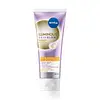Nivea Cellular Luminous630 Anti Dark-Spot Post-Acne Marks Serum Versus Nivea Luminous Skin Glow Whip Foam
What's inside
What's inside
 Key Ingredients
Key Ingredients

 Benefits
Benefits

 Concerns
Concerns

 Ingredients Side-by-side
Ingredients Side-by-side

Water
Skin ConditioningAlcohol Denat.
AntimicrobialGlycerin
HumectantTapioca Starch
Salicylic Acid
MaskingCarbomer
Emulsion StabilisingIsobutylamido Thiazolyl Resorcinol
BleachingSodium Hyaluronate
HumectantCamellia Sinensis Leaf Extract
AntimicrobialPanthenol
Skin ConditioningPantolactone
HumectantIsoquercitrin
AntioxidantGlucosylrutin
AntioxidantGlycyrrhiza Inflata Root Extract
Skin ConditioningAmmonium Acryloyldimethyltaurate/Vp Copolymer
Decylene Glycol
Skin ConditioningCitric Acid
BufferingTrisodium EDTA
Sodium Chloride
MaskingSodium Sulfate
Sodium Hydroxide
BufferingSodium Benzoate
MaskingParfum
MaskingCI 42090
Cosmetic ColorantCI 16035
Cosmetic ColorantWater, Alcohol Denat., Glycerin, Tapioca Starch, Salicylic Acid, Carbomer, Isobutylamido Thiazolyl Resorcinol, Sodium Hyaluronate, Camellia Sinensis Leaf Extract, Panthenol, Pantolactone, Isoquercitrin, Glucosylrutin, Glycyrrhiza Inflata Root Extract, Ammonium Acryloyldimethyltaurate/Vp Copolymer, Decylene Glycol, Citric Acid, Trisodium EDTA, Sodium Chloride, Sodium Sulfate, Sodium Hydroxide, Sodium Benzoate, Parfum, CI 42090, CI 16035
Water
Skin ConditioningPEG-8
HumectantMyristic Acid
CleansingGlycerin
HumectantStearic Acid
CleansingPotassium Hydroxide
BufferingButylene Glycol
HumectantLauric Acid
CleansingPalmitic Acid
EmollientGlyceryl Stearate Se
EmulsifyingCitrus Sinensis Fruit Extract
AntioxidantSodium Acetylated Hyaluronate
HumectantSodium Hyaluronate
HumectantHydrolyzed Sodium Hyaluronate
Skin ConditioningSodium Hyaluronate Crosspolymer
HumectantSodium Ascorbyl Phosphate
AntioxidantUbiquinone
AntioxidantPolyquaternium-7
Arachidic Acid
CleansingOleic Acid
EmollientCera Alba
EmollientPentylene Glycol
Skin ConditioningSodium Benzoate
MaskingTrisodium EDTA
Parfum
MaskingWater, PEG-8, Myristic Acid, Glycerin, Stearic Acid, Potassium Hydroxide, Butylene Glycol, Lauric Acid, Palmitic Acid, Glyceryl Stearate Se, Citrus Sinensis Fruit Extract, Sodium Acetylated Hyaluronate, Sodium Hyaluronate, Hydrolyzed Sodium Hyaluronate, Sodium Hyaluronate Crosspolymer, Sodium Ascorbyl Phosphate, Ubiquinone, Polyquaternium-7, Arachidic Acid, Oleic Acid, Cera Alba, Pentylene Glycol, Sodium Benzoate, Trisodium EDTA, Parfum
 Reviews
Reviews

Ingredients Explained
These ingredients are found in both products.
Ingredients higher up in an ingredient list are typically present in a larger amount.
Glycerin is already naturally found in your skin. It helps moisturize and protect your skin.
A study from 2016 found glycerin to be more effective as a humectant than AHAs and hyaluronic acid.
As a humectant, it helps the skin stay hydrated by pulling moisture to your skin. The low molecular weight of glycerin allows it to pull moisture into the deeper layers of your skin.
Hydrated skin improves your skin barrier; Your skin barrier helps protect against irritants and bacteria.
Glycerin has also been found to have antimicrobial and antiviral properties. Due to these properties, glycerin is often used in wound and burn treatments.
In cosmetics, glycerin is usually derived from plants such as soybean or palm. However, it can also be sourced from animals, such as tallow or animal fat.
This ingredient is organic, colorless, odorless, and non-toxic.
Glycerin is the name for this ingredient in American English. British English uses Glycerol/Glycerine.
Learn more about GlycerinParfum is a catch-all term for an ingredient or more that is used to give a scent to products.
Also called "fragrance", this ingredient can be a blend of hundreds of chemicals or plant oils. This means every product with "fragrance" or "parfum" in the ingredients list is a different mixture.
For instance, Habanolide is a proprietary trade name for a specific aroma chemical. When used as a fragrance ingredient in cosmetics, most aroma chemicals fall under the broad labeling category of “FRAGRANCE” or “PARFUM” according to EU and US regulations.
The term 'parfum' or 'fragrance' is not regulated in many countries. In many cases, it is up to the brand to define this term.
For instance, many brands choose to label themselves as "fragrance-free" because they are not using synthetic fragrances. However, their products may still contain ingredients such as essential oils that are considered a fragrance by INCI standards.
One example is Calendula flower extract. Calendula is an essential oil that still imparts a scent or 'fragrance'.
Depending on the blend, the ingredients in the mixture can cause allergies and sensitivities on the skin. Some ingredients that are known EU allergens include linalool and citronellol.
Parfum can also be used to mask or cover an unpleasant scent.
The bottom line is: not all fragrances/parfum/ingredients are created equally. If you are worried about fragrances, we recommend taking a closer look at an ingredient. And of course, we always recommend speaking with a professional.
Learn more about ParfumSodium Benzoate is a preservative. It's used in both cosmetic and food products to inhibit the growth of mold and bacteria. It is typically produced synthetically.
Both the US FDA and EU Health Committee have approved the use of sodium benzoate. In the US, levels of 0.1% (of the total product) are allowed.
Sodium benzoate works as a preservative by inhibiting the growth of bacteria inside of cells. It prevents the cell from fermenting a type of sugar using an enzyme called phosphofructokinase.
It is the salt of benzoic acid. Foods containing sodium benzoate include soda, salad dressings, condiments, fruit juices, wines, and snack foods.
Studies for using ascorbic acid and sodium benzoate in cosmetics are lacking, especially in skincare routines with multiple steps.
We always recommend speaking with a professional, such as a dermatologist, if you have any concerns.
Learn more about Sodium BenzoateSodium Hyaluronate is hyaluronic acid's salt form. It is commonly derived from the sodium salt of hyaluronic acid.
Like hyaluronic acid, it is great at holding water and acts as a humectant. This makes it a great skin hydrating ingredient.
Sodium Hyaluronate is naturally occurring in our bodies and is mostly found in eye fluid and joints.
These are some other common types of Hyaluronic Acid:
Learn more about Sodium HyaluronateWe don't have a description for Trisodium EDTA yet.
Water. It's the most common cosmetic ingredient of all. You'll usually see it at the top of ingredient lists, meaning that it makes up the largest part of the product.
So why is it so popular? Water most often acts as a solvent - this means that it helps dissolve other ingredients into the formulation.
You'll also recognize water as that liquid we all need to stay alive. If you see this, drink a glass of water. Stay hydrated!
Learn more about Water